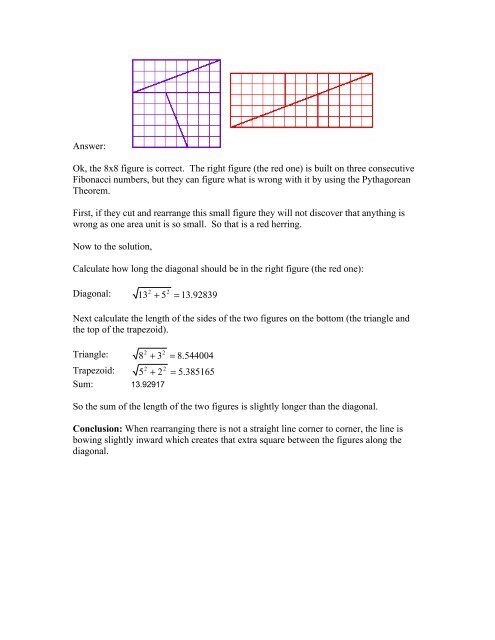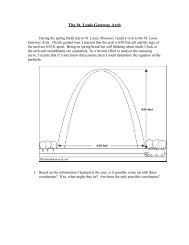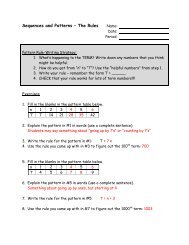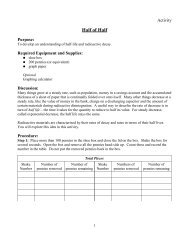64 = 65? Still Not Convinced? But this can not be true what is the ...
64 = 65? Still Not Convinced? But this can not be true what is the ...
64 = 65? Still Not Convinced? But this can not be true what is the ...
You also want an ePaper? Increase the reach of your titles
YUMPU automatically turns print PDFs into web optimized ePapers that Google loves.
Answer:<br />
Ok, <strong>the</strong> 8x8 figure <strong>is</strong> correct. The right figure (<strong>the</strong> red one) <strong>is</strong> built on three consecutive<br />
Fibonacci num<strong>be</strong>rs, but <strong>the</strong>y <strong>can</strong> figure <strong>what</strong> <strong>is</strong> wrong with it by using <strong>the</strong> Pythagorean<br />
Theorem.<br />
First, if <strong>the</strong>y cut and rearrange <strong>th<strong>is</strong></strong> small figure <strong>the</strong>y will <strong>not</strong> d<strong>is</strong>cover that anything <strong>is</strong><br />
wrong as one area unit <strong>is</strong> so small. So that <strong>is</strong> a red herring.<br />
Now to <strong>the</strong> solution,<br />
Calculate how long <strong>the</strong> diagonal should <strong>be</strong> in <strong>the</strong> right figure (<strong>the</strong> red one):<br />
2 2<br />
Diagonal: 13 + 5 = 13.92839<br />
Next calculate <strong>the</strong> length of <strong>the</strong> sides of <strong>the</strong> two figures on <strong>the</strong> bottom (<strong>the</strong> triangle and<br />
<strong>the</strong> top of <strong>the</strong> trapezoid).<br />
2 2<br />
Triangle: 8 + 3 = 8.544004<br />
Trapezoid:<br />
2 2<br />
5 + 2 = 5.3851<strong>65</strong><br />
Sum: 13.92917<br />
So <strong>the</strong> sum of <strong>the</strong> length of <strong>the</strong> two figures <strong>is</strong> slightly longer than <strong>the</strong> diagonal.<br />
Conclusion: When rearranging <strong>the</strong>re <strong>is</strong> <strong>not</strong> a straight line corner to corner, <strong>the</strong> line <strong>is</strong><br />
bowing slightly inward which creates that extra square <strong>be</strong>tween <strong>the</strong> figures along <strong>the</strong><br />
diagonal.





